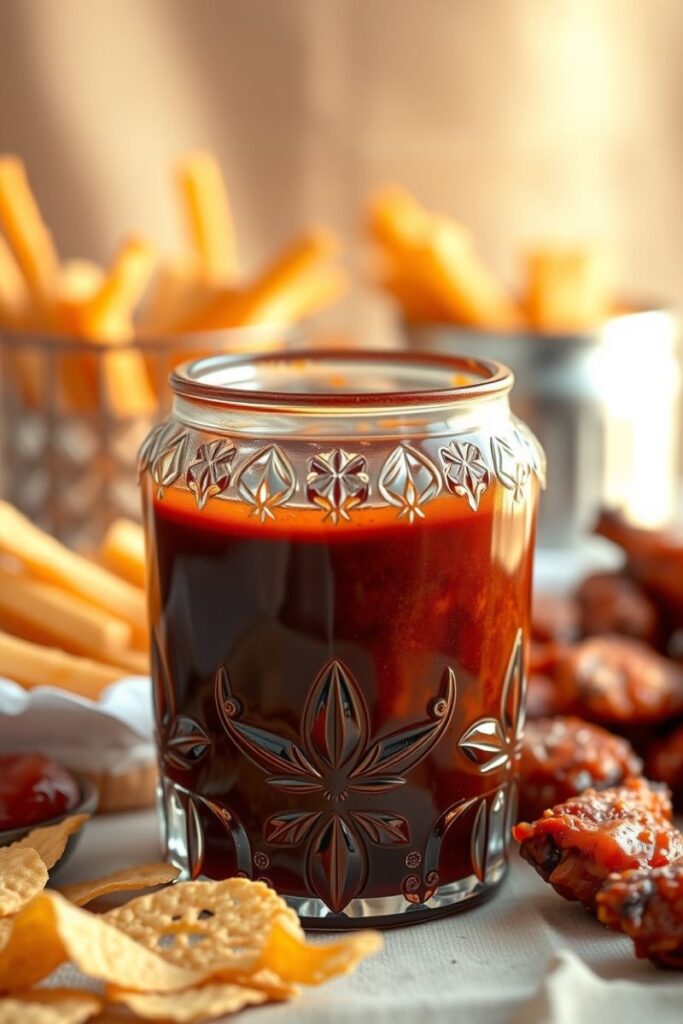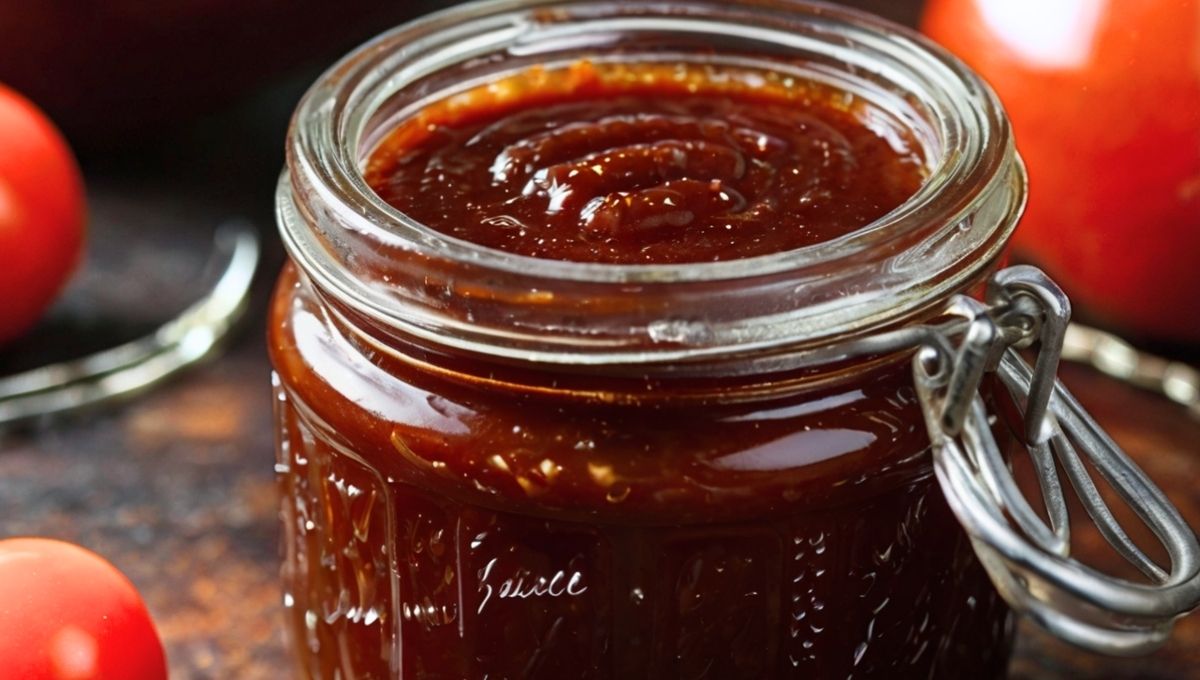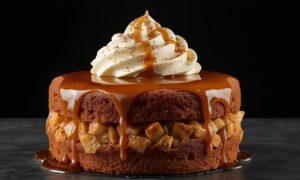The first time I tasted real, scratch-made barbecue sauce, it was a revelation. Standing in my uncle’s backyard in Tennessee, watching him stir a bubbling pot that filled the air with sweet, smoky aromas that seemed to dance with the hickory smoke. Commercial sauces never tasted the same again. That’s the thing about the best homemade BBQ sauce; once you’ve experienced the depth and complexity of homemade, those store bought bottles collecting dust in your fridge door suddenly feel like distant, inferior cousins.
BBQ sauce ain’t just a condiment. It’s history in a jar, cultural identity by the spoonful. What makes the best homemade BBQ sauce isn’t just following a recipe, it’s understanding the balancing act between sweet, tangy, spicy, and savory elements that create that perfect harmony that keeps folks coming back for more. And let me tell ya, mastering this balance is both art and science.
The Flavor Foundations of Great BBQ Sauce
Great homemade BBQ sauce revolves around five fundamental taste elements: sweetness, acidity, heat, savory depth, and that elusive umami. Each BBQ sauce recipe and regional style emphasizes different aspects of this flavor pentagram. Carolina BBQ sauce leans heavily into vinegar’s tang. Kansas City BBQ sauce embraces molasses-like sweetness. Texas BBQ sauce often keeps things minimal, letting the meat’s natural flavor shine through.
Finding your perfect barbecue sauce means understanding these elements and how they interact. Like a good band, each ingredient should know when to take center stage and when to provide backup. The acid cuts through fattiness. The sweetness balances heat. The umami deepens everything. It’s BBQ sauce chemistry in a saucepan, really.
What separates amateur sauce from professional BBQ sauce concoctions? Layering and developing flavors through proper technique. Many folks just throw ingredients in a pot and simmer, but building complexity requires more finesse. Caramelizing onions properly, blooming spices in oil to release aromatics, deglazing with the right liquid at the right moment, these techniques compound into that “There’s just something about it” quality that elevates homemade BBQ sauce.
Ingredients & Substitutions

The Base
- Tomato foundation: Most American BBQ sauces start with either tomato paste (concentrated flavor), crushed tomatoes (more fresh brightness), or ketchup (pre balanced with vinegar and sugar). For depth without excessive sweetness, I recommend combining 6 oz tomato paste with 1 cup crushed tomatoes.
- Vinegar: Apple cider vinegar brings fruity tang that balances sweetness beautifully. White vinegar works in a pinch but misses those apple notes. For less acidity with unique character, try rice vinegar or even a splash of quality bourbon.
- Sweeteners: Dark brown sugar provides molasses notes that granulated sugar lacks. Honey contributes floral complexity, while maple syrup adds woodsy undertones. I often combine 1/2 cup brown sugar with 2 tablespoons honey for dimension.
Aromatics and Spices
- Alliums: Yellow onions caramelized slowly form the flavor foundation, but don’t overlook shallots for elegance or smoked garlic for depth. Bout 1 medium onion, diced fine, is my go to.
- Spice blend: Paprika (sweet, hot, or smoked) provides color and earthy notes. Mustard powder adds pungency. Black pepper brings heat that builds rather than smacks you. Cayenne delivers immediate heat if desired.
- Enhancers: Worcestershire sauce delivers instant umami through its fermented anchovies. Soy sauce or coconut aminos work similarly. For smoke without a smoker, smoked salt or a few drops of liquid smoke makes magic happen.
Flavor Amplifiers
- Fruit elements: Unexpected but transformative grated apple adds natural pectin and sweetness. Peach preserves introduce Southern charm. Even a few tablespoons of orange juice brightens everything.
- Spirits: Bourbon’s vanilla and caramel notes meld perfectly with BBQ flavors, while cooking off the alcohol. Rum brings tropical molasses character. Even a splash of coffee liqueur can add mysterious depth.
- Secret ingredients: A tablespoon of instant espresso powder enhances meatiness. Fish sauce sounds alarming but disappears while amping up umami. Two tablespoons of pickle juice adds brightness that nobody will identify but everyone will appreciate.
For folks with dietary restrictions, coconut sugar substitutes well for brown sugar. Tamari works for gluten free needs instead of soy sauce. Apple butter can replace tomato paste for nightshade allergies, though the profile shifts considerably.
Step by Step Instructions for Homemade BBQ Sauce
Phase 1: Building the Foundation
- Sweat the aromatics properly. Heat 2 tablespoons neutral oil in a heavy bottomed saucepan over medium low heat. Add finely diced onion with a pinch of salt and cook slowly about 10 12 minutes until translucent with golden edges. This creates sweetness without burning. Many home cooks rush this step, missing crucial flavor development.
- Bloom your spices. Clear a small space in the center of the pan, add another tablespoon of oil, and add your ground spices (2 tablespoons paprika, 1 tablespoon mustard powder, 1 teaspoon black pepper, 1/2 teaspoon cayenne if using). Cook for 30-60 seconds until fragrant, stirring constantly. This wakes up fat soluble flavor compounds that would remain dormant if added straight to liquid.
- Incorporate your tomato base. Add tomato paste first, stirring into the spices and cooking for 2-3 minutes until it darkens slightly and smells less raw. This caramelizes the natural sugars and removes the tinny flavor. Then add crushed tomatoes, stirring to integrate completely with the sautéed elements.
Phase 2: Balancing Act
- Add vinegar gradually. Pour in 1/2 cup apple cider vinegar, scraping any fond (those flavorful brown bits) from the bottom of the pan. The mixture will steam and might splatter, so stand back a bit. Let it reduce by about a quarter before proceeding.
- Incorporate sweeteners mindfully. Add your brown sugar and honey, stirring until completely dissolved. The sauce will become glossier and slightly thicker. Avoid dumping all sweeteners at once, taste as you go. Remember that flavors intensify as the sauce reduces, so slight under sweetening now prevents cloying results later.
- Introduce depth enhancers. Add 2 tablespoons Worcestershire sauce, 1 tablespoon soy sauce, and any additional enhancers like liquid smoke (just a few drops) or 1 teaspoon espresso powder. These ingredients don’t need lengthy cooking, just sufficient integration.
Phase 3: Refinement
- Simmer with purpose. Reduce heat to low and maintain a gentle simmer for 25-30 minutes, stirring occasionally to prevent scorching. A splatter screen helps contain mess. The sauce should reduce by about a third, coating the back of a spoon. A common mistake is cooking too hot or too briefly, which fails to marry the flavors properly.
- Adjust consistency. If the sauce becomes too thick, add water or stock a tablespoon at a time. If too thin, continue simmering uncovered. For silky smooth texture, use an immersion blender or transfer carefully to a standard blender after cooling slightly. For more rustic sauce, leave as is.
- Final seasoning. Turn off heat and adjust seasoning. Remember that flavors dull when cold, so a sauce that tastes perfectly balanced hot may need more brightness when cooled. Add salt, additional vinegar, or even a splash of lemon juice to brighten. For extra complexity, consider a tablespoon of butter swirled in off heat for richness and sheen.
For a spicier version, double the cayenne or add 1 tablespoon of your favorite hot sauce during the final seasoning step. For a kid friendly adaptation, eliminate cayenne entirely and increase the honey by a tablespoon for sweeter approach.
Cooking Techniques & Science
Understanding the culinary science behind homemade BBQ sauce elevates your sauce making from recipe following to true mastery. The Maillard reaction, that beautiful browning that happens when proteins and sugars heat up, creates hundreds of new flavor compounds. This is why properly caramelizing onions and browning tomato paste transforms your sauce from flat to dimensional.
Reduction concentrates more than just consistency. As water evaporates, volatile compounds become more pronounced, while others mellow through continued heat exposure. Acids brighten but also break down cellular structures, which is why long simmered tomatoes taste fundamentally different from fresh ones. This transformation creates that cooked-all-day flavor that makes homemade BBQ sauce special.
Temperature control proves crucial throughout the process. Too hot, and sugars burn rather than caramelize, creating bitter notes. Too cool, and you’ll miss developing proper fond, those flavorful bits that stick to the pan and contribute depth when deglazed. A heavy bottomed pan distributes heat evenly, preventing hot spots that can ruin your sauce. If ya don’t have a good thick-bottomed pot, consider investing in one, it makes all the difference.
The thickening properties of BBQ sauce come from multiple sources. Tomato paste contains natural pectin. Sugars contribute to viscosity as they concentrate. Even the reduction itself removes water, bringing particles closer together. Understanding these mechanisms allows you to troubleshoot if your sauce isn’t thickening; you might need more reduction rather than additional ingredients.
Storage & Aging for Homemade BBQ Sauce
Homemade BBQ sauce behaves like fine wine or bourbon, it gets better with age, to a point. After cooling completely, transfer to sterilized glass jars (never store in reactive metal containers). Refrigerated, it keeps for 2–3 weeks, with flavors melding and deepening after 48 hours. That initial rest period allows harsh edges to soften and individual ingredients to harmonize.
For longer preservation, proper canning techniques with a water bath ensure shelf stability for up to a year. The high acid content helps prevent spoilage, but proper sealing remains essential. Alternatively, freeze portions of homemade BBQ sauce in ice cube trays, then transfer to freezer bags for convenient small-batch use over 3–4 months.
The sauce’s texture may change slightly upon thawing or after prolonged refrigeration. A quick whisk or a few seconds in the microwave restores proper consistency. Color may also darken over time. This is normal oxidation and doesn’t indicate spoilage as long as there’s no off smell or mold present.
Serving & Pairing Suggestions

Classic application involves brushing sauce onto meats during the final stages of cooking, allowing it to set into a glossy glaze without burning. The sugar content causes easy scorching, so apply during the last 15-20 minutes of cooking. For additional layers, serve extra sauce on the side, warmed slightly to awaken the aromatics.
Beyond the expected ribs and brisket applications, this BBQ sauce elevates unexpected dishes. Drizzle over brick pressed grilled chicken for a weeknight transformation. Blend with mayo for an elevated burger spread. Mix with cream cheese as a surprising crostini topping. Even breakfast gets a makeover try a spoonful mixed into your next batch of savory breakfast hash.
For traditionalists, pair this sauce with slow smoked pork shoulder, beef brisket, or St. Louis style ribs. The complex flavors complement the rich fattiness of these cuts. For poultry, brush on grilled chicken thighs rather than breasts the higher fat content stands up better to the sauce’s boldness.
Beverage pairings should stand up to the sauce’s assertiveness. An oaked Zinfandel echoes the sauce’s sweetness while providing tannic structure. For beer lovers, a malty amber ale or brown ale complements without overwhelming. Non alcoholic options include sweet tea with lemon or a tart lemonade that refreshes between rich bites.
Regional Variations
While my core recipe leans toward Kansas City style with its tomato sweetness balance, simple modifications create authentic regional expressions:
- Carolina style transformation: Double the vinegar, reduce sugar by half, add 1 tablespoon of prepared yellow mustard, and increase black pepper substantially. This thin, tangy sauce cuts through fatty pulled pork beautifully.
- Texas inspired adaptation: Reduce tomato by half, double the black pepper, add 1 teaspoon of cumin, and incorporate 1/4 cup strong brewed coffee. This creates a thinner, less sweet sauce perfect for beef.
- Alabama white sauce detour: Replace tomato components with 1 cup mayonnaise, 1/3 cup apple cider vinegar, plenty of black pepper, and a touch of prepared horseradish. This creamy variation transforms grilled chicken and turkey.
- Memphis dry rub liquid analogue: Increase brown sugar, add 1 tablespoon celery seed, and incorporate 2 teaspoons cinnamon for a sweet forward sauce that forms a beautiful bark when applied to ribs.
Every region’s sauce reflects its history and available ingredients. These variations aren’t just recipes, they’re cultural artifacts, telling stories of migration, agriculture, and tradition through flavor.
Conclusion
Creating The Best Homemade BBQ Sauce is less about strict recipes and more about understanding flavor balance. Once you grasp the basics, you can customize to suit your taste.
Great sauce comes from good technique and patience. Take your time with caramelizing, blooming spices, and slow simmering these steps build deep, complex flavor that shortcuts can’t match.
Your sauce will evolve as it sits. Let it rest, taste it again, and adjust gradually. With each batch, you’ll sharpen your instincts and turn cooking into creativity.
Make it yours. Use local honey, a special vinegar, or a spice from your heritage. The Best Homemade BBQ Sauce isn’t just made, it’s crafted with a personal touch.
FAQs
Can I reduce the sugar without losing flavor?
Yes! Use naturally sweet ingredients like grated carrots or bell peppers. Caramelized onions also add sweetness, letting you cut added sugar by up to one third.
How can I thicken a thin sauce?
Add 2 tablespoons of tomato paste and simmer. For quicker results, use a cornstarch slurry (1 tsp cornstarch + 1 tbsp water). A spoonful of unsweetened fruit preserves also thickens and adds depth.
How do I get real smoke flavor without liquid smoke?
Use chipotle in adobo, smoked paprika, or smoked salt. For deeper flavor, smoke ingredients like onions and garlic before adding them to the sauce.
Why does my sauce separate after storing?
Separation happens due to fat or temperature shifts. Whisk well during cooking and let the sauce come to room temp before reheating. If needed, blend briefly to restore texture.
Can I use this for competition BBQ?
Yes, with tweaks. Add ¼ cup brown sugar, 2 tbsp corn syrup, and cook longer for thickness and shine. Some pros add a dash of artificial butter flavor for mouthfeel.

Swiftly Captions by Tina Smith — Quick, flavorful food recipes made simple, bringing fresh inspiration to your kitchen every day






